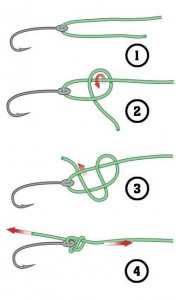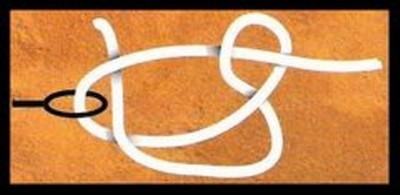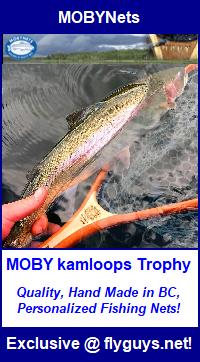[embedit snippet=”gas-auto-responsive-link-ad-minimalist”]
Fly Fishing Knots | Davy Wotton Knot
* recently updated to included the stronger Double Davy Wotton knot! 😉
The Davy Wotton Knot | History:
I was on a local fly fishing forum the other day and noticed a thread titled “which knot to tie fly on”. After reading through the entire thread (51 posts in all so far) it occurred to me that not one person had mentioned the knot that I have been using almost exclusively for the last few years. Clinch knot, improved clinch knot, turle knot, trilene knot, loop knot, nail knot, duncan loop knot, etc, etc, etc – they were all there but after trying em all I finally settled on one that has proven to be very strong, very simple to tie, and has the very low profile beneficial for fishing the tiny stuff. The knot is called the Davy Wotton and it’s the first fly fishing knot in what is sure to become a new flyguy category! 🙂
The story behind the knot is that Davy Wotton, one of the coaches in the World Youth Fly Fishing Championships and long time competitor for the Welsh national fly fishing team, through trial and error invented a knot that allowed him to attach a fly in seconds – a critical requirement when competing.
The Davy Wotton knot, unlike other knots that are used to attach flies to tippet, does not require the tippet to be pulled down on the knot to burn and weaken the mono and therefor has a very high break strength – almost 100% I’m told. I have used this knot for the last few years without a single failure – and I’ve horsed in a few lunkers that I’m sure would have compromised lesser knots! 😯
The Davy Wotton knot is quick, strong, and has yet to let me down. Here’s how to tie the Davy Wotton fly fishing knot …
The Davy Wotton Knot | Tying Instructions:
The knot is so simple to tie that it sometimes seems difficult but once you figure it out and use it you will not use another one! Here’s the tying instructions:
 Take your fly and pass your tippet through the bottom of the eyelet. Turn the fly upside down so the hook point is turned up or on the top.
Take your fly and pass your tippet through the bottom of the eyelet. Turn the fly upside down so the hook point is turned up or on the top.- With the fly extended to the left, pull or extend about three or four inches of tippet through the eye.
- Take your tag piece of mono and pass over the top of the main leader from the back side and draw it back through, making a loop. The tag end will be pointing away from you.
- Take the tag and pass it under (towards you), then over the top of the bottom leg of the loop, once again ending with the tag end pointing away from you.
- To secure the knot, bite the tag piece and pull the leader end taut, causing the knot to close. If you have tied the Davy knot properly, you should hear and feel a little “click” as you pull everything tight … the knot is firmly fastened and will not slip.
The Davy Wotton Knot | Update: the “Double Davy”:
We contemplated making the “Double Davy Knot” it’s own separate post but reconsidered as it maintains the same characteristics of its predecessor (the original Davy Knot) but with the added benefit of strength at a slight cost of a bigger profile. As it seems that most original Davy knot “slippage” issues that we read about were experienced when utilized on larger patterns, and therefore bigger hooks, the incremental increase in knot size of the Double Davy is probably insignificant. Regardless, here’s how to tie the Double Davy Wotton fly fishing knot …
The Double Davy Wotton Knot | Tying Instructions:
* The tying steps for the Double Davy knot are the same as for the original Davy knot up to step number 4. The additional loop in step 5 is the only difference between the two knots.
- Take your fly and pass your tippet through the bottom of the eyelet. Turn the fly upside down so the hook point is turned up or on the top.
- With the fly extended to the left, pull or extend about three or four inches of tippet through the eye.
- Take your tag piece of mono and pass over the top of the main leader from the back side and draw it back through, making a loop. The tag end will be pointing away from you.
- Now take the tag and pass it under (towards you), then over the top of the bottom leg of the loop, once again ending with the tag end pointing away from you.
- And finally pass the tag over the top of the main leader loop (towards you) and draw it back under (away from you). Again the tag should be pointing away from you.
- To secure the knot, bite the tag piece and pull the leader end taut, causing the knot to close. If you have tied the Double Davy knot properly, you should hear and feel a little “click” as you pull everything tight … the knot is firmly fastened and will not slip.
[embedit snippet=”gas-auto-responsive-link-ad-minimalist”]
And because a picture is worth 1000 words …….
I still use the Davy knot for all styles of fly fishing and I’m totally convinced that this is one of the best fly fishing knot available for securing a fly to the leader tippet. And although I have not experienced the knot slippages that others have, I now add an extra turn to create the Double Davy knot whenever fishing flies over size #12 or when on stillwater lakes with trophy trout potential (rainbow trout over eight pounds). Either way, the original Davy Wotton knot or the newer Double Davy Wotton knot, give it a try, I think you’ll agree!
*** for more information on fly fishing knots please visit our fly fishing knots page! There’s also a printer friendly version in case you want to print them out and carry them with you!
[embedit snippet=”gas-matched-content-ti-ar”]
Like our stuff? Subscribe by ![]() Feed or
Feed or ![]() Email
Email .jpg)












I have asked this in a couple of forums. Can you use a Davy knot to tie tippet to tippet and leave a tag on one end to tie the fly to in a 2 or 3 fly rig? Most say that an Orvis tippet knot or a surgeons knot is what should be used, but why couldn’t a Davy knot be used here as well as at the hook connection? Any input would be appreciated.
Well here in BC we can’t rig up a multiple fly set up so I have never tried it. Like most I use a double and sometimes triple surgeons knot to tie tippet to tippet but in theory I can’t see why the Davy knot wouldn’t work.
Have you ever tried it? If not why not tie one up and give it a good test pull (like you should on all your knots anyway) and see if it holds. If it passes the test I’d say it’s good to go! 🙂
The Davy Knot looks simplistically brilliant! Especially for the tiny stuff. I can’t wait to test it.
I’m wondering if this might be THE fastest, easiest knot to teach kids to tie? Catch us on http://www.troutninjatv.com
I concentrate on teaching how to catch stocked trout. Thanks! ~Trout Ninja